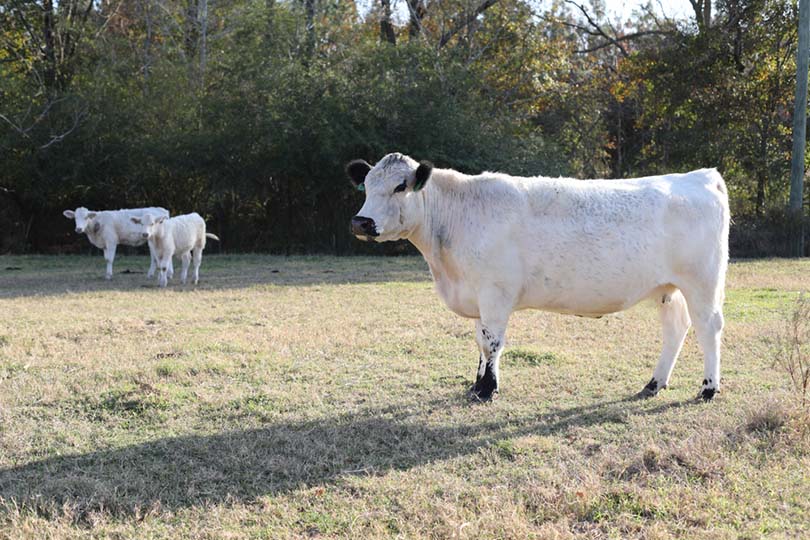British Whites are some of the oldest cattle breeds native to the United Kingdom. They have survived for thousands of years and have evolved into resilient, hardy, and productive livestock. According to the Rare Breed Trust, these cattle are rare and are on the Rare Breeds Survival Trust in the UK. They are generally used for beef production, although some farmers do use them for milk.
Keep reading to find out more about these rare cattle and their origins, uses, and the characteristics that make them special.

Quick Facts about British White Cattle
| Breed Name: | British White |
| Place of Origin: | Whalley Abbey, Lancashire |
| Bull (Male) Size: | 1,800 – 2,300 pounds |
| Cow (Female) Size: | 1,000 – 1,500 pounds |
| Color: | White |
| Lifespan: | 20+ years |
| Climate Tolerance: | High heat tolerance |
| Care Level: | Easy |
| Production: | Beef and milk |
British White Cattle Breed Origins
The British White breed is one of the oldest cattle breeds in Britain and has a direct link to ancient indigenous wild cattle. They originated from Whalley Abbey, Lancashire. Around 1765, nearly all of these cattle were wiped out and breeders of these cattle worked hard for many years to maintain their numbers. Over time, blood from other breeds had to be introduced in order to stop problems with inbreeding.
By the start of the 20th century, more people started to become aware of these outstanding cattle and their unique qualities. They soon grew in desirability, and more of this rare breed began to emerge.

British White Cattle Breed Characteristics
While there are a lot of special characteristics about the British White breed, some stand out more than others. These cattle have a moderate body size, with females weighing between 1,000–1,500 pounds and bulls weighing between 1,800–2,300 pounds. Some breeders prefer to crossbreed these cattle because they provide the rare quality of being medium in size while still growing well and producing good-quality meat and dairy.
British Whites are docile in nature with high intelligence. This makes it easy to handle them. They are also relatively trouble-free in that they have few problems with disease. They are also naturally polled, meaning that they don’t have horns and are easier to handle.
- Quality beef
- Growth and hardiness
- Tick tolerant
- Maternal instincts
- Fertile and easy calving
- Milking ability
Uses
The two main uses for British White cattle are beef production and their milking and mothering abilities.
Beef
Most beef consumers today do not want beef that is too tough or fatty. At the same time, you don’t want to sacrifice the tenderness of the meat or the overall taste. You have to find a happy medium between the two. British White cattle are the perfect choice for farmers wanting to produce high-quality beef for consumers. The meat is still very lean with excellent flavor.
These cattle often have light flecking in their muscle that makes the perfect quality for a roast or steak and is nearly fat-free without sacrificing flavor.
Milking and Mothering
The mothering and milking of cows doesn’t seem all that important when their main purpose is to grow good beef. However, they both play a major role in meat production. Calves grow based on their mother’s ability to produce an abundance of nutritious milk. The cows are excellent mothers with a good set of udders for their babies to latch on to. Because of the rich milk they produce, they are able to grow their calves into excellent animals for beef production.
Appearance & Varieties
British White cows, whether purebred or crossbred, are naturally polled. They are white in color with red or black points (ears, muzzle, nose, eyelids, hooves, teats, tongue). Their skin is typically pink with blue pigments on their points. Because of their pigmentation, they can suffer from issues with sunburn and eye cancer at times. They have strong black hooves that hold their shape and rarely need hoof paring.
Distribution/Habitat
After surviving for thousands of years, the British White cattle have developed hardiness that allows them to live in all types of climate conditions. They have been exported all around the world, including places like North America, Australia, and Brazil. They thrive in a range of climate zones but have exceptional hardiness to hot weather. You can allow them to range for long periods without having to worry about their survival.

Are British White Cattle Breed Good for Small-Scale Farming?
Because of their rarity to this day, small-scale farming might be your only option for raising British White cattle. While the numbers for these cows are harder to find for other countries, there are currently only 1,117 breeding females in the UK.
If you do decide to raise these cattle, then they are a good choice for small-scale farming. They are easy to handle, docile in temperament, and generally easy to care for.

Final Thoughts
It’s unfortunate that there aren’t more of these cows being raised in the world. They are among the oldest breeds from Great Britain and some of the easiest to handle, while producing excellent beef and dairy. They almost disappeared a couple of hundred years ago, so we’re happy to see that their numbers have stabilized. British Whites are beautiful cows and an excellent choice for anyone interested in raising livestock.
Featured Image Credit: Cowen Duggar, Shutterstock
